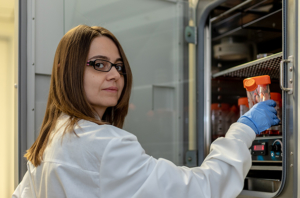Giorgia Quadrato, an assistant professor in USC’s Department of Stem Cell Biology and Regenerative Medicine, was recently awarded an Edward Mallinckrodt Foundation (EMF) grant to further her research about modeling human brain development and disease.
Quadrato is one of five fellows nationally to receive this competitive award in 2020. Other recipients are in the fields of neurobiology, microbiology, metabolic diseases, and pediatrics. She is the third faculty member to receive this prestigious award at USC. Previous awardees are Dr. Dion Dickman and Dr. Irene Chiolo, who are both faculty members in the Department of Biological Sciences at the USC Dornsife College of Letters, Arts and Sciences. Mallinckrodt Grants provide up to three years of support for faculty in the biomedical sciences during the initial years of their faculty appointments, with a goal of furthering scientific investigations related to the diagnosis and treatment of disease.
Quadrato will use her EMF Grant to develop a model for testing human brain development and connectivity. The brain is one of the most complex human biological systems, and animal models cannot fully recapitulate its development and processes. To create a better way to study human development and disease, she recently demonstrated that brain-like structures, called organoids, can be grown in the lab from patient-derived stem cells. These provide a three-dimensional model to visualize abnormalities in neuronal development.
Quadrato points out that while human brain organoids provide a system for studying cellular neurodevelopmental processes, they do not provide an optimal platform for studying disorders involving more complex levels of neuronal dysfunction, including abnormalities in structural and functional connectivity.
“Brain imaging studies have provided evidence of dysfunctional connectivity between distinct brain regions in many developmental disorders, including autism spectrum disorders (ASD),” she said. “We are interested in evolving current brain organoid models to model disfunction of long-range connectivity in organoids derived from patients with ASD.”
To address these challenges, Quadrato has teamed up with other labs and departments at USC to design new platforms for studying neuropsychiatric diseases and pharmacological effects on those conditions. She is leveraging the benefits of interdepartmental cooperation and the academic synergies between stem cell research, neurology, genetics, and biomedical engineering.
“The success of this project will require exchange and collaboration with experts in other fields,” said Quadrato. “We are grateful to the Mallinckdrot Foundation for their investment in this research that will give us the opportunity to strengthen our collaboration with the USC laboratories of Dr. Megan McCain, who is an expert in tissue engineering, and Dr. Marcelo Coba, who is an expert in systems biology approaches to studying synaptic plasticity.”
